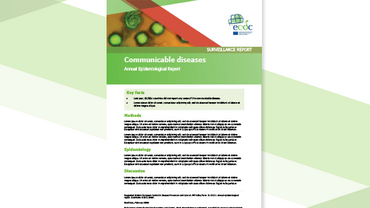Surveillance of invasive bacterial diseases in Europe 2008/2009
This report describes the epidemiology of invasive bacterial diseases due to Haemophilus influenzae and Neisseria meningitidis in the European Union Member States in 2008 and 2009. Out of the 30 EU/EEA Member States, 29 submitted data.
The majority of participating countries have a passive and compulsory surveillance system in place for both diseases. In 2008–2009, 9 615 cases of invasive bacterial disease due to N. meningitidis were notified in the EU/EEA. Meningococcal disease appears to be rare in the majority of Member States. The two most affected countries were Ireland and the UK, although in both countries there is a sustained declining trend. A total of 3 572 cases of invasive Haemophilus influenzae disease were reported in 2008 and 2009. The notification rates varied across the Member States and the rates in the Nordic countries, in particular Sweden and Norway, were higher compared to the rest of Europe.
Executive Summary
Invasive bacterial infections caused by H. influenzae and N. meningitidis pathogens represent a significant public health problem across Europe due to the rapid onset of the disease, high case fatality and the high proportion of surviving patients with severe complications, such as permanent disabilities including neurological sequelae and subsequent death.
Children below 5 years are the most affected age group. Early diagnosis and treatment play an essential role in the control of invasive bacterial disease.
The introduction of mass vaccination against the meningococcal C strain in several European countries has resulted in a dramatic decrease in the number of reported cases due to serogroup C in the last decade. Meningococcal disease remains rare in Europe with almost twofold decrease of incidence compared to the 1999 rate (1.9 per 100 000).
Similarly, the incidence of H. influenzae type b disease has decreased substantially after the introduction of the vaccine on a national level, and has contributed immensely to changing the epidemiology of the disease.
The surveillance of these diseases is important to study the epidemiological trends and to monitor the circulating strains, as incidence varies geographically and temporally. Since the number of cases is decreasing because of the availability of effective vaccines, pooling European data together increases the power of the epidemiological analysis.





